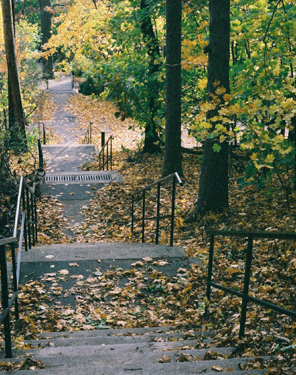Summit Path has drama. Long and steep, the path leads to the top of Corey Hill, 260 feet above sea level, and rewards the intrepid hiker with a commanding view of Boston and the surrounding landscape. Shady, with a dense tree canopy, the path provides a long, quiet, enclosed passage up the steep hillside. There's a sense of seclusion that contrasts vividly with the wide-open vista at the top.
The granddaddy of all the paths, Summit Path distinguishes itself by virtue of its 791 foot length. It makes its way up the steep southwest slope of Corey Hill in three sections, crossing the terraced roadways that were built into the hillside to open the hill to residential development.

Near Washington Square on Beacon Street, the beginning of Summit Path is marked with the cobblestone pillars and formidable slate slabs and steps that once marked the entrance to Eben Jordan's 1890 estate, Stonehurst. This first section climbs up between several large apartment buildings, reaching Lancaster Terrace near its intersection with Mason Terrace.
The Middle SectionsThe second section of the path continues across Mason Terrace, passing a beautiful stone wall draped with ivy and other climbing vines, and painted with the address "2". Here, a wooden bench provides an inviting respite. Continuing up the hill, the landscape becomes more heavily forested, as the path runs parallel to the steep backyards of homes along the terraced roadways. A tree in the middle of the path was carefully saved, with the pathway's pavement encircling its large trunk. Another bench at York Terrace marks the beginning of the third section. Across York Terrace, the path remains bordered by large trees and plentiful plant life, reaching Summit Avenue at the site of the Corey Hill Park. Created with the town's purchase of two pieces of land in 1900 and 1915, the park assures continued public access to the ever-popular commanding view. Late in the nineteenth century, a picnic outing to the summit was a popular Sunday activity, with 400 visitors being recorded on one such day.
Historical Corey Hill

Known as "The Great Hill", Corey Hill was covered with wooded groves, pastures, and working farms in the 18th century. Timothy Corey settled on the hill in 1760, and his descendants ran a dairy farm. The construction of Beacon Street in 1851 made the land accessible as never before, and by the 1870's the beautiful countryside was luring some prosperous Boston businessmen to build large country estates on the hill. The most famous of these was Stonehurst, built in 1890 by Eben Jordan of Jordan Marsh department store fame. It was his son, Eben Jordan Jr., who petitioned the Selectmen to accept the upper two sections of the path as a public way in 1893. The lower section was accepted in 1904.
Summit Path was the first of three paths created on Corey Hill. By traversing the hillside directly, the walk up or down is significantly shortened when compared to travel on the roadways, and perfectly illustrates the practicality of the paths. Summit Path provides the experience of a short stroll in the woods, allowing the walker time to become grateful for the shady, quiet alternative to the busy street.
